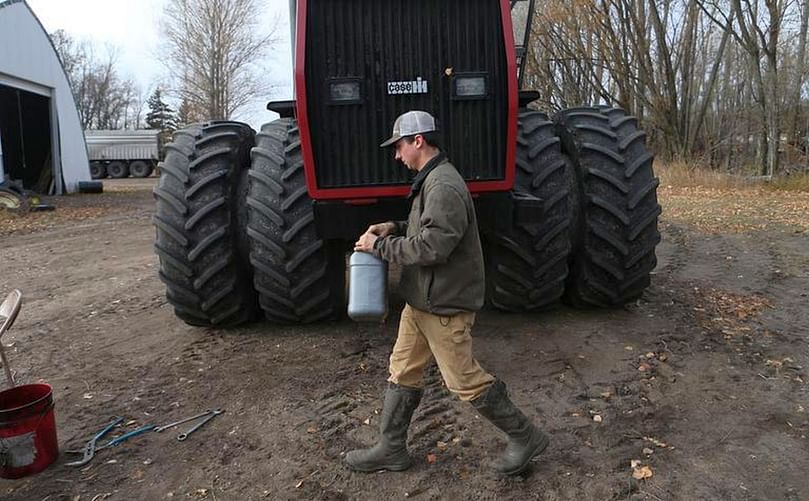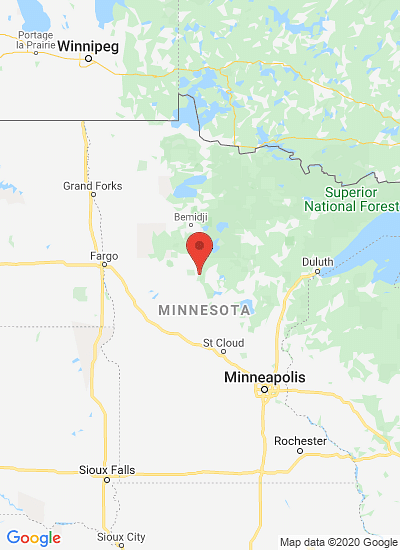Sander Dagen, a seed potato farmer from Karlstad, Minn., checks a warehouse where he and his father and brother store potatoes Monday in Karlstad. (Courtesy: Eric Hylden | Grand Forks Herald)
Thousands of seed potato acres in the Red River Valley will go to waste

Sander Dagen raised an exceptional seed potato crop this year in Karlstad, Minnesota. That makes it sting even more as he is forced to abandon approximately 80% of his acres because he cannot harvest them.
Sander Dagen, a seed potato farmer from Karlstad, Minn:
“You spend a year planning this out.”The Karlstad farmer, like other seed potato farmers in the Red River Valley, had to abandon acres because wet weather delayed the harvest for several weeks. After rains and snow, freezing temperatures destroyed the crop.
“To have to destroy them is a little bit sad for sure.”
Dagen’s family, who have grown seed potatoes for 101 years, have lost acres to heavy summer rains that drowned out the crop, but never such a large amount during harvest, he said. Dagen individually lost 69 of his 85 seed potato acres.
Overall, Dagen, his brother Brooks and their father Justin lost about one-third of their collective 400 acres.
This year the Minnesota Department of Agriculture certified 4,933 acres of seed potatoes in the state, said Eric Byre, Minnesota Department of Agriculture plant protection manager. However, the certification was done before the crops were harvested and don’t reflect crop losses.
Eric Byre, Minnesota Department of Agriculture plant protection manager:
“The growers that were in the Red River Valley are the ones that are impacted the most.”The story is similar on the North Dakota side of the Red River, where the biggest share of the potatoes that didn’t get harvested are in the Red River Valley, said Ken Bertsch, North Dakota State Seed Department commissioner.
“Seed potato acreage near Stephen, Minn., for example, wasn’t harvested at all, and a farmer near Nielsville, Minn., harvested only one-third of his acres.”

Karlstad, Minn., seed potato farmer Sander Dagen changes oil on a tractor before putting it away for winter. (Courtesy: by Eric Hylden | Grand Forks Herald)
Sander Dagen:
“It’s very difficult,”Dagen, 25, only has been farming for five years, so the financial hit will be significant. He isn’t sure yet whether his seed potato losses will be covered by federal crop insurance. Even if it does, it will only cover a portion of the loss.
“I’ve never seen a fall like this. They were just unable to get their acreage.”
“It was the 300% of average precipitation that we got in September and October that made our fields a sticky mire that couldn’t hold the tractor,”
“... noting that about 12 inches of rain fell during the two months.”
“We went out to my field Oct. 10 in muck boots and we would sink up to our ankles.”
“They finally froze on the third of October. That put the potatoes to their final doom.”
“Crop losses are difficult any time of year, but it costs more when it happens in the fall.”
“This year we had a beautiful crop. ... You keep spending on the inputs the whole season, whereas if it had drowned out in June or July you would have stopped putting money into it. ... It’s really disappointing, spending all this money, spending all this time.”
This year reiterated for Dagen and his family that no matter how hard they work on the farm, the outcome isn’t entirely in their hands, he said.
Dagen:
“We learned when it comes to farming, faith trumps skill and all these things are out of control.”A sixth-generation farmer, Dagen already is getting his machinery ready for the 2020 farming season and hopeful that it will be better.
“God is in control.”
“Hopefully, all this rain is just once in a hundred years. It’s the natural optimism farmers have.”
¿Te gustaría recibir noticias como esta por correo electrónico? ¡Únete y suscríbete!
Get the latest potato industry news straight to your WhatsApp. Join the PotatoPro WhatsApp Community!
Contenido Patrocinado
Contenido Patrocinado
Contenido Patrocinado
Contenido Patrocinado






